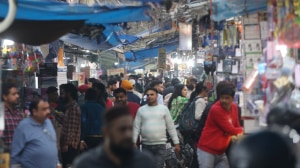Stay updated with the latest - Click here to follow us on Instagram
In dark Kashmir valley,a ray of light from India’s economic surge
The rapid growth of India's giant economy is finally exerting a pull on the troubled Kashmir Valley.
In a cheerful hall humming with voices,rows of young men and women handle calls from irate cellphone subscribers in eastern India in perfect Hindi.
It could be an outsourcing centre in Bangalore or Hyderabad. But this is insurgency-scarred Kashmir.
As call centres go,the 230-seat office in a run-down industrial quarter of Kashmir’s summer capital,Srinagar,is small compared with offices that pack in up to 3,000 workers in India’s big cities.
The centre,run by Essar Group’s business processing arm,AEGIS,is the first of its kind in the region.
But if the steady stream of 25 to 30 youth who show up at the office each day looking for jobs is any gauge,the rapid growth of India’s giant economy is finally exerting a pull on the troubled Kashmir Valley.
Over the next few months AEGIS will add another 270 seats,employing up to a thousand shift workers. Its executives,many of them Kashmiris who have worked in India and abroad,say it is only the beginning,given the opportunities exploding in one of the world’s fastest growing economies.
TOURISM RETURNS
Indeed,planeloads of India’s upwardly mobile middle classes have visited the picture postcard-perfect Kashmir Valley this summer,making it the busiest tourist season since the armed revolt began in 1989.
Hotels and the famed houseboats on the mirror-calm Dal lake framed by snowcapped mountains are booked for weeks even though new ones such as the Taj chain’s luxurious Vivanta have opened.
The streets are blocked with traffic,the shops are filled with customers bargaining for everything from carpets to walnuts.
Kashmir cannot it seems,escape the power of India’s $1.6 trillion economy growing at 8 percent despite severe problems of governance that have taken the shine off the country as an investment destination.
We are here because it makes absolute business sense to be here,said Omar Wani,the operations head of the Srinagar call centre sitting in his office as a steady stream of people arrive looking for work,sometimes young girls accompanied by their father or a brother.
My hiring costs are zero. No advertisements,no headhunters. It’s just word of mouth. I get walk-ins every day and most are graduates.
A brief training session follows,including in Hindi,and the young man or woman — hired at a monthly salary of Rs 7,000 rupees — is ready to take the first call.
Yes we get abusive customers,but that is what our job is about,we have to tackle them,says Tahoor,a team leader,smiling as she listens in to the conversations of her colleagues watching for mis-steps.
Some of the callers are not even literate,such as a street-side vegetable seller in a small town in eastern India,part of the country’s massive mobile phone market,which adds more than 15 million subscribers a month.
Try asking them what is the IMEI number,and see what you get,said Wani,referring to the unique identification number embedded in each handset.
It is still too early,and the gains could be wiped out just as quickly if there is a renewed bout of unrest,but the signs that Kashmir’s economic isolation is ending are unmistakable.
FEEDING INDIA’S CONSUMERS
It’s not just not information technology that is cracking open the Valley.
In a report last week,Mercy Corps,an international agency seeking to light an entrepreneurial fire among Kashmiri youth,documented stories of young men and women who have launched business ventures in the past few years,meeting India’s hunger for everything from flowers to holidays.
One of them is Irfan Wani,28,who returned to Kashmir in 2005 after working as a sales executive for pharmaceutical firms to set up a company to cultivate and market cut flowers such as Oriental lilium,Asiatic lilium,and gladiola.
A Delhi-based firm soon became his main client and each day thousands of cut flowers are flown into the nation’s capital.
Wani later expanded his business to produce strawberries and high-value vegetables like bell peppers and cherry tomatoes which have a bigger market outside Kashmir. His KVB Agro Farms,one of the largest agri-flori firms in the region is expected to reach an annual turnover of Rs 19 million ($430,000) over the next three years.
Another young entrepreneur figured out that the lack of a cold chain was preventing apple farmers from competing in the Indian market flush with produce from as far away as the United States and China.
Khurram Mir,a 30-year-old,U.S.-educated Kashmiri,established a 500-tonne integrated cold chain facility for storage,ripening and primary processing for fruits and vegetables in Pulwama in southern Kashmir. He provides farmers with a post-harvest facility to store their produce for 10 months with no risk to its quality.
It’s like we are just waking up from a time warp. The last 15 years just skipped us by. Forget the big cities like Delhi. It is even in next-door Punjab you can see the scale of change,the opportunities available,said Usmaan Ahmad who heads Mercy Corps in Kashmir and one of a growing band of expatriate Kashmiris who returned to work in his native place.
FRAGILE GAINS
Ahmad and several others involved in Kashmir’s rehabilitation say these entrepreneurial success stories are only the first tiny steps,and very fragile.
This is the first summer of peace after three years of some of the biggest Separatist protests.
Last year tens of thousands of stone-pelting youths filled town squares across the Valley,angered by the death of a 17-year-old boy who was hit a police tear gas shell.
Businesses took a hit: Mercy Corps estimates that the 2008 unrest wiped out a fifth of the state’s GDP. The constant worry is that conflict could erupt anytime again. All it needs is a spark.
We are one death away from market collapse,said Ahmad.
Last month there were concerns again after a youth died in police custody in the town of Sopore,a bastion of Separatist sentiment. Protests have taken place in the town and a strike was called,but the situation has not spiralled out of control.
Kashmir’s youth can ill-afford another bout of instability. Like many developing societies around the globe,Kashmir is experiencing a youth bulge,where 71 per cent of the population is under the age of 35. Of the large cohort of youth between the ages of 18 to 30 in the Kashmir Valley,an estimated 48 per cent are currently unemployed.
In a recent survey conducted by the London-based think tank Chatham House,96 per cent of respondents from the Kashmir Valley identified unemployment as one of the main problems facing the state of Jammu & Kashmir along with conflict and corruption.
The challenge for Kashmir is how does it manage the youth bulge,said Ahmad. It could be a demographic dividend or a disaster.







